The relationship between quiet quitting and turnover intention in nurses: A systematic review and meta-analysis

Published 2025-06-25
Keywords
- Quiet Quitting, Turnover Intention, Nurses, Systematic Review, Meta-Analysis
- Sessiz İstifa, İşten Ayrılma Niyeti, Hemşireler, Sistematik İnceleme, Meta Analiz
How to Cite
Copyright (c) 2025 Eray Ekin Sezgin

This work is licensed under a Creative Commons Attribution-NonCommercial-NoDerivatives 4.0 International License.
How to Cite
Abstract
Although some recent research has shown a positive association between quiet quitting and turnover intention among nurses, a thorough systematic review on this topic has yet to be conducted. Addressing the gaps in this area will provide a clearer understanding of the dynamics influencing nurses' turnover intentions and shed light on the development of future preventive strategies. This meta-analytic review aimed to integrate and critically assess the relationship between quiet quitting and turnover intention among nurses. All studies had a cross-sectional design and were conducted from 2023 onwards. A comprehensive search of six databases, including ScienceDirect, Medline, JSTOR, ProQuest, Scopus, and Web of Science, was conducted to gather empirical studies for this meta-analytic research. The results indicated a moderate, positive relationship between quiet quitting and turnover intention (r = 0.40, p < 0.0001). Furthermore, the overall effect size showed consistency, and the heterogeneity level (I² = 94.7%) was considered within acceptable thresholds. Further in-depth research is required to gain a clearer understanding of how quiet quitting influences turnover intention. To prevent quiet quitting, nursing managers should establish clinical guidelines and support programs that promote nurses' professional development and enhance their job satisfaction and commitment to the profession. In this way, nurses can achieve more satisfaction and motivation in their workplaces, and thus their turnover intentions can be reduced.
References
- Anand, A., Doll, J., & Ray, P. (2023). Drowning in Silence: A Scale Development and Validation of Quiet Quitting and Quiet Firing. International Journal of Organizational Analysis, 32(4), 721-743. https://doi.org/10.1108/ IJOA-01-2023-3600
- Bae, S. H. (2022). Noneconomic and Economic Impacts of Nurse Turnover in Hospitals: A Systematic Review. International Nursing Review, 69(3), 392-404. https://doi.org/10.1111/inr.12769
- Barrett, J. R. (2024). Quiet Quitting: A Conceptualisation, Scale Development and Validation. Master's thesis, Auburn University, Alabama.
- Buchan, J., & Catton, H. (2023). Recover to Rebuild. Investing in the Nursing Workforce for Health System Effectiveness. International Council of Nurses.
- Bayrakci, E. (2022). Hemşirelerde işten ayrılma niyeti ve performans ilişkisi: covid-19 tükenmişliğinin düzenleyici rolü. İşletme Araştırmaları Dergisi, 14(1), 835-845. https://doi.org/10.20491/isarder.2022.1413
- Chen, Y., Zhou, X., Bai, X., Liu, B., Chen, F., Chang, L., & Liu, H. (2024). A systematic review and meta-analysis of the effectiveness of social support on turnover intention in clinical nurses. Frontiers in Public Health, 12, 1393024. https://doi.org/10.3389/fpubh.2024.1393024
- Chu, X., Zhang, L., & Li, M. (2022). Nurses' strengths use and turnover intention: The roles of job crafting and self-efficacy. Journal of Advanced Nursing, 78(7), 2075-2084. https://doi.org/10.1111/jan.15124
- Cohen, J. (2013). Statistical Power Analysis for the Behavioural Sciences, 2nd ed.; Academic Press: Cambridge, MA, USA.
- Galanis, P., Katsiroumpa, A., Vraka, I., Siskou, O., Konstantakopoulou, O., Katsoulas, T., ... & Kaitelidou, D. (2024a). Nurses quietly quit their job more often than other healthcare workers: An alarming issue for healthcare services. International nursing review, 71(4), 850-859. https://doi.org/10.1111/inr.12931
- Galanis, P., Moisoglou, I., Katsiroumpa, A., Gallos, P., Kalogeropoulou, M., Meimeti, E., & Vraka, I. (2025). Workload increases nurses' quiet quitting, turnover intention, and job burnout: evidence from Greece. AIMS Public Health, 12(1), 44-55. https://doi.org/10.3934/publichealth.2025004
- Galanis, P., Moisoglou, I., Katsiroumpa, A., Vraka, I., Siskou, O., Konstantakopoulou, O., & Kaitelidou, D. (2024b). Moral resilience reduces levels of quiet quitting, job burnout, and turnover intention among nurses: evidence in the post COVID-19 era. Nursing Reports, 14(1), 254-266. https://doi.org/10.3390/nursrep14010020
- Galanis, P.; Moisoglou, I.; Malliarou, M.; Papathanasiou, I.V.; Katsiroumpa, A.; Vraka, I.; Siskou, O.; Konstantakopoulou, O.; Kaitelidou, D. (2023). Quiet Quitting among Nurses Increases Their Turnover Intention: Evidence from Greece in the Post-COVID-19 Era. Healthcare, 12(1), 79. https://doi.org/10.3390/healthcare12010079
- Galanis, P., Moisoglou, I., Papathanasiou, I. V., Malliarou, M., Katsiroumpa, A., Vraka, I., ... & Kaitelidou, D. (2024c). Association between organisational support and turnover intention in nurses: A systematic review and meta-analysis. In Healthcare 12(3), 291. https://doi.org/10.3390/healthcare12030291
- Gallup. (2023). State of the Global Workplace: 2023 Report. Erişim tarihi: 28/03/2025. https://www.scribd.com/document/654992676/Gallup-State-of-the-Global-Workplace-2023-Report.
- Geng, R., Geng, X., & Geng, S. (2025). Identifying Key Antecedents of Quiet Quitting Among Nurses: A Cross‐Profession Meta‐Analytic Review. Journal of Advanced Nursing, 0, 1-21. https://doi.org/10.1111/jan.16934
- Gün, İ., Çetinkaya Kutun, F., & Söyük, S. (2025). Mediating Effect of Turnover Intention on the Relationship Between Job Burnout and Quiet Quitting in Nurses. Journal of Advanced Nursing, 1-9. https://doi.org/10.1111/jan.16807
- Higgins, J. P., & Thompson, S. G. (2002). Quantifying heterogeneity in a meta‐analysis. Statistics in Medicine, 21(11), 1539-1558. https://doi.org/10.1002/sim.1186
- Higgins, J.P.T., Thompson, S.G., Deeks, J.J. & Altman, D.G. (2003). Measuring Inconsistency in Meta-Analyses. BMJ, 327, 557-560. https://doi.org/10.1136/bmj.327.7414.557
- International Council of Nurses. ICN report says shortage of nurses is a global health emergency (2023). https://www.icn.ch/news/icn-report-says-shortage-nurses-global-health-emergency. Erişim tarihi: 14/03/2025.
- Karrani, M. A., Bani-Melhem, S., & Mohd-Shamsudin, F. (2024). Employee quiet quitting behaviours: conceptualisation, measure development, and validation. The Service Industries Journal, 44(3-4), 218-236. https://doi.org/10.1080/02642069.2023.2286604
- Kang, J., Kim, H., & Cho O-H. (2023). Quiet quitting among healthcare professionals in hospital environments: a concept analysis and scoping review protocol. BMJ Open, 13:e077811. https://doi.org/10.1136/bmjopen-2023-077811
- Kim, K. T., & Sohn, Y. W. (2024). The Impact of Quiet Quitting on Turnover Intentions in the Era of Digital Transformation: The Mediating Roles of Job Satisfaction and Affective Commitment, and the Moderating Role of Psychological Safety. Systems, 12(11), 460. https://doi.org/10.3390/systems12110460
- Lo, W.Y., Chien, L.Y., Hwang, F.M., Huang, N. & Chiou S.T. (2018). From job stress to intention to leave among hospital nurses: a structural equation modelling approach. Journal of Advanced Nursing, 74(3), 677-88. https://doi.org/10.1111/jan.13481
- Mafula, D., Arifin, H., Chen, R., Sung, C. M., Lee, C. K., Chiang, K. J., ... & Chou, K. R. (2025). Prevalence and Moderating Factors of Turnover Rate and Turnover Intention Among Nurses Worldwide: A Meta-Analysis. Journal of Nursing Regulation, 15(4), 20-36. https://doi.org/10.1016/S2155-8256(25)00031-6
- McGuinness, L. A., & Higgins, J. P. (2020). Risk‐of‐bias VISualization (robvis): an R package and Shiny web app for visualising risk‐of‐bias assessments. Research Synthesis Methods, 12(1), 55-61. https://doi.org/10.1002/jrsm.1411
- Mobley, W.H. (1982). Employee Turnover: Causes, Consequences, and Control, MA, Addison-Wesley.
- Moher, D., Liberati, A., Tetzlaff, J., Altman, D. G., & PRISMA Group (2009). Preferred reporting items for systematic reviews and meta-analyses: The PRISMA statement. Annals of Internal Medicine, 151(4), 264-269. https://doi.org/10.1016/j.ijsu.2010.02.007
- Moisoglou, I., Katsiroumpa, A., Katsapi, A., Konstantakopoulou, O., & Galanis, P. (2025). Poor Nurses' Work Environment Increases Quiet Quitting and Reduces Work Engagement: A Cross-Sectional Study in Greece. Nursing Reports, 15(1), 19. https://doi.org/10.3390/nursrep15010019
- Nadiri, H., & Tanova, C. (2010). An investigation of the role of justice in turnover intentions, job satisfaction, and organisational citizenship behaviour in hospitality industry. International Journal of Hospitality Management, 29(1), 33-41. https://doi.org/10.1016/j.ijhm.2009.05.001
- Nam, S., Wong, J. Y. H., & Fong, D. Y. T. (2025). Factors Associated With Turnover Intention Among Nurses: A Quantile Regression Analysis. Journal of Clinical Nursing, 1-12. https://doi.org/10.1111/jocn.17698
- Ren, H., Xue, Y., Li, P., Yin, X., Xin, W., & Li, H. (2024a). Prevalence of turnover intention among emergency nurses worldwide: a meta-analysis. BMC Nursing, 23(1), 645. https://doi.org/10.1186/s12912-024-02284-2
- Ren, H., Li, P., Xue, Y., Xin, W., Yin, X., & Li, H. (2024b). Global prevalence of nurse turnover rates: A meta‐analysis of 21 studies from 14 countries. Journal of Nursing Management, 1, 5063998. https://doi.org/10.1155/2024/5063998
- Rossi, M. F., Beccia, F., Gualano, M. R., & Moscato, U. (2024). Quiet Quitting: The Need to Reframe a Growing Occupational Health Issue. Social Work, 69(3), 313-315. https://doi.org/10.1093/sw/swae023
- Selçuk, D., & Seren, A. K. H. (2024). Hemşirelerde İşten Ayrılma Niyeti ile Zorunlu Vatandaşlık Davranışı Arasındaki İlişki. Sağlık ve Hemşirelik Yönetimi Dergisi, 11(1), 11-21. https://doi.org/10.54304/SHYD.2024.82956
- Spector, P.E., Dwyer, D.J., & Jex, S.M. (1988). Relation of Job Stressors to Affective, Health, and Performance Outcomes: A Comparison of Multiple Data Sources. J. Appl. Psychol., 73, 11-19. https://doi.org/10.1037/0021-9010.73.1.11
- Toska, A., Dimitriadou, I., Togas, C., Nikolopoulou, E., Fradelos, E. C., Papathanasiou, I. V., ... & Saridi, M. (2025). Quiet Quitting in the Hospital Context: Investigating Conflicts, Organizational Support, and Professional Engagement in Greece. Nursing Reports, 15(2), 38. https://doi.org/10.3390/nursrep15020038
- Viechtbauer, W. (2010). Conducting meta-analyses in R with the metafor package. Journal of Statistical Software, 36, 1-48. https://doi.org/10.18637/jss.v036.i03
- Wang, X., Liu, M., Leung, A. Y., Jin, X., Dai, H., & Shang, S. (2024). Nurses' job embeddedness and turnover intention: A systematic review and meta-analysis. International Journal of Nursing Sciences, 11, 563-570. https://doi.org/10.1016/j.ijnss.2024.10.003
- World Health Organization, International Council of Nurses. Nursing now state of the world's nursing 2020: investing ineducation, jobs and leadership. (2020). https://iris.who.int/bitstream/handle/10665/331677/9789240003279-eng.pdf?sequence=1, erişim tarihi: 11/03/2025.
- Yıkılmaz, R. (2022). Quiet quitting: A conceptual investigation. Anadolu 10th International Conference on Social Science, Diyarbakır, Türkiye.
- Zuzelo, P.R. (2023). Discouraging quiet quitting: Potential strategies for nurses. Holist Nurs Pract, 37, 174-175. https://doi.org/10.1097/HNP.0000000000000583



